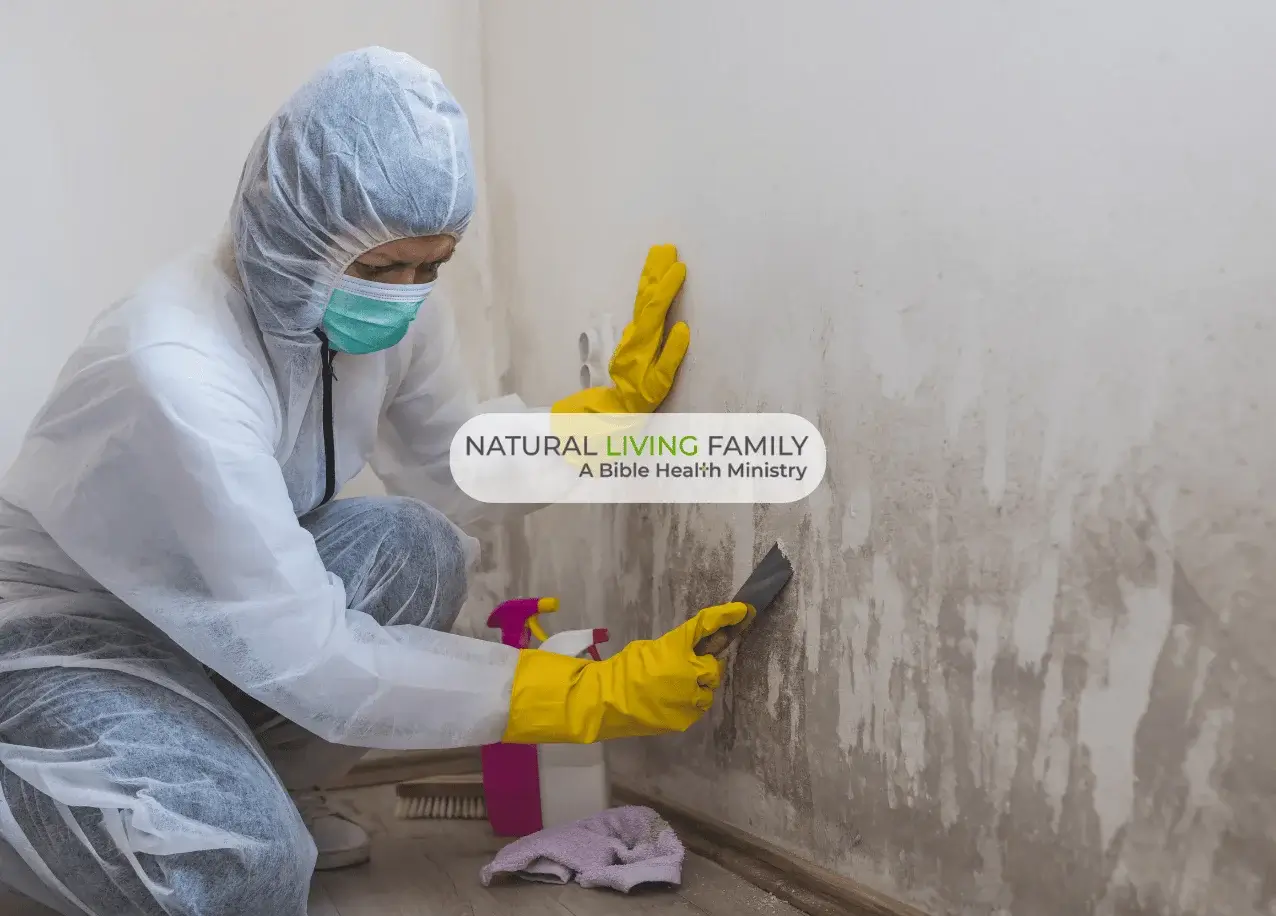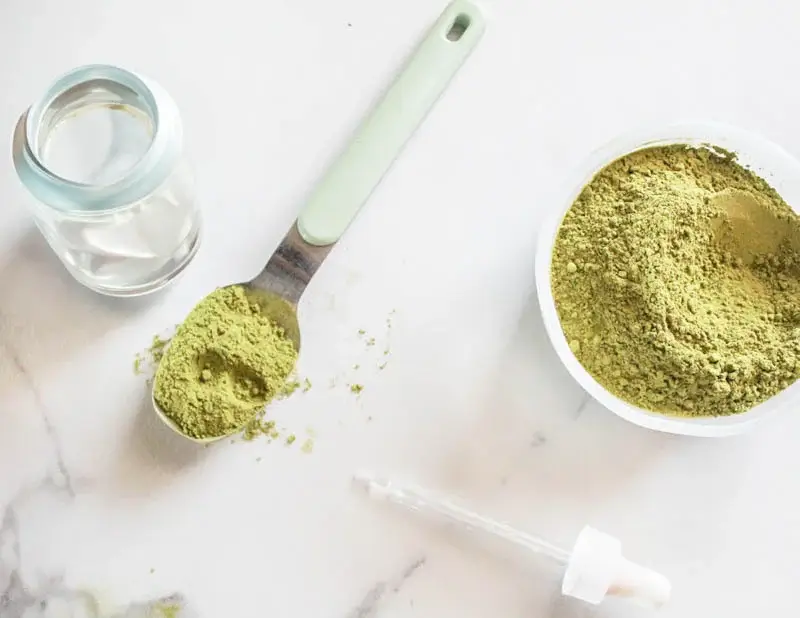In our interview with Dr. Peter Osborne, he shared his personal story of dealing with toxic mold so don’t miss that. In the course of the interview, he mentioned six pillars of how to detox your body from mold naturally that are must-dos, so we will take a deeper look at those here.
Table of Contents
What Happens When Mold Gets In Your Home
Mold is more than a nuisance. It is a silent destroyer of health. Exposure can damage your cardiovascular system, brain, gut, hormones, and immune function. Dr. Osborne identifies three distinct forms of mold-related illness:
- Mold allergy – A common immune response to mold spores, leading to respiratory symptoms (like sneezing, runny nose, and congestion) and sometimes skin inflammation. Mold allergy symptoms can mimic other conditions, making them easy to overlook, so be aware!
- Mycotoxin poisoning – Some molds produce toxic byproducts called mycotoxins, which may accumulate in the body. This mold toxicity contributes to a range of symptoms, including fatigue, headaches, and cognitive issues. These effects are sometimes referred to as “toxic mold syndrome” or chronic inflammatory response syndrome (CIRS).
- Mold infections – In rare cases, especially in people with weakened immune systems, mold can actually grow inside the body, leading to infections.
Each form can wreak havoc even if there are no visible signs of mold in your home. That’s why awareness, good testing protocols, and proactive steps are key.
Symptoms of Mold Exposure & Health Concerns
Mold exposure can look a little different in each person, but certain patterns are common. Unfortunately a lot of symptoms can overlap with other chronic conditions, which is why mold is frequently missed as a root cause until it’s progressed. Here are some common signs.
Allergic Reactions
What do you think of when you think of seasonal allergies? Symptoms like sneezing, runny nose, red eyes, and skin rashes. For those with mold allergies, even small exposures to mold spores can trigger significant reactions.
Respiratory Issues
Mold growth in the home can inflame the lungs, triggering coughing, wheezing, sinus congestion, and asthma-like symptoms. If you’ve never had a history of respiratory problems and suddenly have shortness of breath all the time, that might be a warning sign you need to not only speak to a health care provider, but possibly test your home for mold as well.
Brain Health
Many people report brain fog, memory issues, difficulty concentrating, mood swings, and even anxiety or depression. Mold toxins are neurotoxic and can impair cognitive function. These neurological symptoms are especially insidious because it can make it hard for you to think clearly at a time when you need to make life and death decisions.
Immune Dysfunction
Chronic exposure can suppress the immune system, making it harder to fight off infections and potentially increasing the chance of developing autoimmune conditions. These increasingly severe symptoms can pull you down and mimic a wide range of health problems.
Skin & Gut Symptoms
Some experience eczema, acne, or persistent rashes. Mold-related digestive tract issues can manifest as bloating, indigestion, or food sensitivities due to its impact on the microbiome. Mycotoxin exposure may also contribute to nutritional deficiencies by affecting digestive health.
Low Energy and Fatigue
One of the most consistent and debilitating symptoms is unrelenting fatigue. One of the effects of mold exposure is the disruption of mitochondrial function in animal models. This robs cells of the energy they need to function and decreases your energy levels as well. Again, at a time when you need to take serious steps to save your family’s health.
Three Steps to Treating Mold Exposure
There are three steps you have to take to stop the decline of your health. And then later there are six pillars of recovery that Doctor Osborne calls non-negotiable. But before you start those six things, make sure these three steps have been completed.
Step One – Get Out of the Mold
“You have to get out of mold to recover. That is number one.” – Dr. Osborne in his interview Toxic Mold: The Truth No One is Telling You
Whether it’s a contaminated home, vehicle, or workspace, you must separate yourself from the exposure to mold, whatever the source. Even low-level, long-term effects of mold exposure can disrupt your health.
In some cases, proper remediation by trained professionals is enough to clean up the moldy environment. In others, a full relocation away from the source of mold may be necessary.
Quality testing is crucial. Many mold inspectors use inaccurate or outdated methods. Dr. Osborne discusses this in detail in our podcast episode, including the importance of:
- Cavity wall sampling
- Mycotoxin air testing
- MSqPCR dust sampling
Find someone trained in true mold assessment, not just surface air testing. Dr. Osborne compares this process to a forensic-level investigation.
Step Two – Clean Up Your Diet
Toxic mold isn’t just in your walls. Mold can be in your pantry too! Certain foods are prone to fungal contamination:
Before running a mycotoxin test, remove these from your diet for at least two weeks to avoid false positives.
A mold detox diet should focus on whole, nutrient-dense foods rich in fiber, antioxidants, and anti-inflammatory compounds. Fiber supports elimination through the bowels, kidneys and liver.
Clean hydration flushes toxins through the kidneys and liver. Avoid sugar and processed foods, which feed mold and suppress immunity.
Step Three – Support Your Body’s Detox Pathways
Your body is always detoxing. But after mold exposure, your detoxification pathways will need extra support.
Dr. Osborne recommends these supplements as part of a mold detox protocol:
- Glutathione – helps move mold toxins out of your tissues. Supplementing to boost your glutathione levels will also help reduce oxidative stress on your body.
- NAC (N-acetylcysteine) – precursor to glutathione. This is a holistic approach to helping your body produce the nutrients needed to detox from mold.
- Vitamin C – supports antioxidant protection and cellular repair. We know that Vitamin C greatly improves cellular health and immune function, which you need during the mold detox process.
- Binders – such as activated charcoal, zeolite, and citrus pectin to absorb and eliminate toxins. Mycotoxin binders and heavy metal detoxifiers like these will all help the natural detoxification processes.
He emphasizes the importance of checking nutrient status as an important part of the detox journey. Mold exposure often depletes essential minerals and B vitamins, which are critical for a healthy detoxification process. Personalized supplementation based on testing is often the most effective strategy.
6 Non-Negotiable Pillars of Natural Mold Detox
Once you’ve worked with professionals to find the source of the mold growth, eliminated it, tested yourself for full understanding of your health status, it’s time to begin your detox and recovery.
These are the six things Doctor Osborne calls non-negotiables to help your body recovery and be restored to health.
“You can’t pick two out of the six. You can’t pick three out of the six. Your body needs all.” – Dr. Osborne in his interview Toxic Mold: The Truth No One is Telling You
1. Clean Diet to Support Full Body Healing
A clean, anti-inflammatory diet is the foundation for recovery. Mold toxins compromise gut function, immune resilience, and nutrient absorption. Prioritize organic vegetables, clean proteins, and healthy fats with a low-mold diet.
Yes, you’ll want to avoid mold-contaminated foods like grains, peanuts, and dried fruit. Eating fresh, whole foods reduces your toxic burden and nourishes your body.
Hydration is equally important. Pure water helps flush toxins and supports kidney and liver function, all important the detoxification pathways. (Try Mama Z’s mix and match approach to infused water if you want naturally flavored water!)
2. Sleep for Restoration
Deep, consistent sleep is essential for healing. During sleep, the brain’s glymphatic system helps clear waste products and supports cognitive health. Even your brain detoxes! That’s in addition to repairing tissue, balancing hormones, and restoring immune defenses. All functions critical after mold exposure.
Mold-related insomnia or anxiety can disrupt sleep patterns, so prioritize sleep hygiene. Make a cool, dark room and turn off your electronics early. If you need extra support try one of our essential oils for sleep blends to help you sleep deep and restoratively.
3. Exercise to Tolerance
Movement supports detox by stimulating the lymphatic system, increasing circulation, and boosting mitochondrial energy production. However, after mold toxicity illness, many people experience fatigue or pain.
Don’t overdo it! Start with gentle movement like walking, stretching, or low-intensity strength work. Use a whole body vibration plate if movement is a challenge. Build up slowly as your body heals. The goal isn’t intensity…it’s consistency.
4. Sunshine for Immune & Mitochondrial Support
Natural sunlight is a powerful tool for healing. It boosts vitamin D levels, which are often depleted in people with mold illness, and helps regulate your circadian rhythm. Sunlight helps regulate circadian rhythms and supports vitamin D production, both of which are important for immune and cellular health.
Aim for 15-30 minutes of outdoor time each day, exposing arms and face when possible. Morning or late-afternoon sun is ideal but see our post about forest bathing benefits for more details and ideas.
5. Clean Water for Internal Cleansing
You are made up of more than 70% water, and quality hydration is essential during detox. Drink filtered or spring water free from contaminants, especially chlorine and fluoride, which may be more likely to stress your detox pathways while you’re still recovering from mold exposure.
Add a pinch of natural sea salt or a splash of lemon to help absorption. Avoid plastic bottles that can leach endocrine-disrupting chemicals into your water.
6. Clean Air to Break the Exposure Cycle
Clean air is non-negotiable because your lungs are a direct pathway for mold toxins. Once you’ve removed yourself from the exposure source, consider investing in a high-quality air purifier with a HEPA and activated carbon filter that can filter out mold spores.
Open windows when air quality is good and avoid synthetic fragrances or sprays that burden your system. This includes your perfume and colognes! Recovery can’t happen while you’re still breathing in mold and putting a strain on your respiratory system.
Hope for Healing No Matter Your Circumstances
Healing from mold isn’t reserved for the wealthy. Dr. Osborne has seen people recover while living in campers or tents. What matters most is removing the source of exposure and committing to the six pillars.
“You get out of it, your brain comes back, and now you can think clearly. . . There’s a way out.” – Dr. Osborne
Even if the path feels overwhelming, you are not alone. With God’s help and a clear action plan, recovery is possible. Start with what you can control today. You were made for healing and you don’t have to do it perfectly. You just have to begin.
- https://www.epa.gov/mold/mold-and-health
- https://pmc.ncbi.nlm.nih.gov/articles/PMC7231651/
- https://www.cdc.gov/niosh/mold/health-problems/index.html
- https://ntp.niehs.nih.gov/research/topics/mold
- https://my.clevelandclinic.org/health/diseases/24862-black-mold
- https://www.sciencedirect.com/science/article/abs/pii/S0889159119303010
- https://pmc.ncbi.nlm.nih.gov/articles/PMC6769180/
- https://www.niehs.nih.gov/health/topics/agents/mold
- https://pubmed.ncbi.nlm.nih.gov/28140328/
- https://pubmed.ncbi.nlm.nih.gov/23462093/
- https://www.frontiersin.org/journals/immunology/articles/10.3389/fimmu.2024.1358341/full
- https://pubmed.ncbi.nlm.nih.gov/24517907/
- https://www.mdpi.com/2076-3921/10/8/1313
- https://pubmed.ncbi.nlm.nih.gov/28587203/
- https://pmc.ncbi.nlm.nih.gov/articles/PMC5707683/
- https://pubmed.ncbi.nlm.nih.gov/2271372/
- https://pmc.ncbi.nlm.nih.gov/articles/PMC9685567/
- https://pmc.ncbi.nlm.nih.gov/articles/PMC3942754/
- https://pmc.ncbi.nlm.nih.gov/articles/PMC4488002/
- Dr. Osborne interview Toxic Mold: The Truth No One is Telling You










